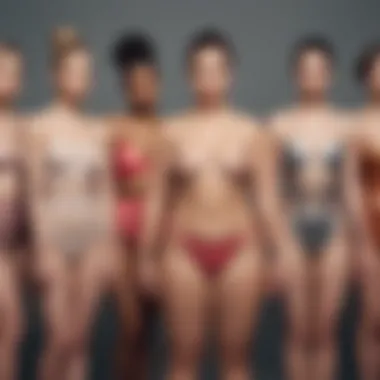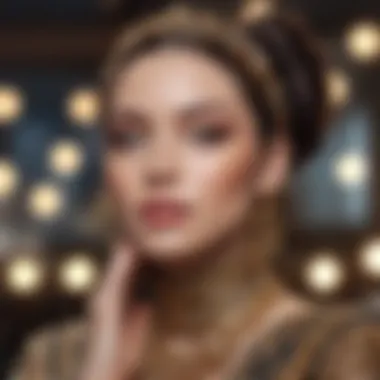Diversity in Fashion and Beauty: A Transformative Approach


Intro
In recent years, diversity in fashion and beauty has moved from being a simple trend to becoming a necessity. This shift addresses the demand for representation across various demographics. In turn, this represents a broader spectrum of beauty, style, and self-expression.
Diversity models help companies understand how to embrace various identities and cultures and engage with a wider audience. By examining these models, both consumers and industry professionals can better grasp the implications for personal style and confidence. Women, especially, benefit as they explore how these changes can redefine their beauty routines and fashion choices.
The subsequent sections will cover important trending topics, provide step-by-step guides, and present in-depth product reviews that reflect these shifts.
Trending Topics
Current Fashion Trends
Fashion has always mirrored society, and the current trends are a testament to that. Today’s fashion emphasizes inclusivity in design and marketing. Brands such as Savage X Fenty, led by Rihanna, showcase a range of body types and skin tones. This approach encourages women of all shapes, sizes, and backgrounds to express their individuality. Not only do these trends promote self-acceptance, but they also challenge the traditional norms that have dominated the industry.
"Diversity in fashion reflects the rich tapestry of human society. It's not just a moral imperative; it's also a smart business strategy."
Beauty Innovations
Innovations in the beauty industry also reflect diversity models. Brands like Fenty Beauty have revolutionized foundation shades, offering an extensive range that suits various skin tones. This commitment to inclusivity allows women to find products that enhance their natural beauty.
Furthermore, the rise of clean beauty products emphasizes the quality and ethical implications of beauty choices. Many consumers are now seeking brands that align with their values, contributing to a shift toward more transparent practices in the industry.
Step-by-Step Guides
Fashion Styling Tips
When embracing diversity in fashion, it is crucial to understand personal style. Here are some practical tips to help women explore their unique fashion identities:
- Identify your body shape: This informs what styles flatter your figure.
- Experiment with colors: Find palettes that complement your skin tone.
- Accessorize thoughtfully: Use accessories to showcase your personality.
- Invest in staple pieces: Items like tailored blazers or classic jeans can be versatile.
Beauty Routines
Creating a beauty routine that embraces diversity begins with recognizing what works best for your individual needs. Consider these steps:
- Understand your skin type: This guides the choice of skincare products.
- Select the right foundation: Ensure it matches your skin tone perfectly.
- Explore diverse techniques: Incorporate methods from different cultures, such as Korean skincare layers.
- Keep it simple: A well-defined routine can be more effective than overly complicated ones.
Product Reviews
In-Depth Analysis of Popular Items
As consumers continue to demand diverse options, several products stand out. For instance, the Fenty Beauty Pro Filt'r Soft Matte Longwear Foundation is highly praised for its extensive shade range and long-lasting formula. Similarly, Too Faced's Born This Way Foundation also offers many options, aligning with diverse skin tones.
Comparative Reviews
When exploring beauty products, comparative analysis can help consumers make informed choices. For example, while Fenty Beauty excels in shade variety, brands like NARS offer high-quality formulations. Understanding the strengths and weaknesses of each brand can assist consumers in finding products that align with their values.
Understanding Diversity in Fashion and Beauty
Diversity in fashion and beauty is a multidimensional concept that encompasses a range of identities including race, age, body type, gender expression, and ability. Understanding this topic is crucial in today's world, as it influences how individuals perceive themselves and others. The implications of diversity touch not only personal identity but also broader societal perceptions.
The growing emphasis on diversity reflects a shift towards inclusivity. Businesses are recognizing that consumers are more informed and influential than ever. By embracing diversity, brands can connect authentically with their audience. This aspect is particularly relevant in fashion and beauty, where representation matters significantly.
Individuals benefit from a diverse landscape as well. When fashion and beauty industries reflect varied perspectives, it fosters a sense of belonging and empowerment among consumers. Feeling represented in marketing campaigns or product lines can enhance self-esteem and comfort in one's skin.
Moreover, understanding diversity in fashion encourages brands to innovate. By considering the different needs and preferences of various consumer groups, companies can create products that resonate more deeply. This can lead to higher engagement and loyalty from consumers.
"Diversity extends beyond mere representation. It involves actively listening to diverse voices and incorporating those insights into products and marketing."


In summary, understanding diversity in fashion and beauty is important because it shapes individual and collective identity, encourages inclusivity, and drives product innovation. The implications of a diverse approach reach far beyond consumerism—it has the potential to create a more inclusive society, informed by the values of respect, representation, and authenticity.
Defining Diversity
Diversity can be understood as the presence of differences within a given setting. In fashion and beauty, this refers to the representation of various demographic groups. This includes variables such as culture, ethnicity, age, gender, and physical ability. Defining diversity is not just about the presence of different identities but also about the respect and value accorded to those identities.
The concept extends to how brands market their products and engage with their audience. Inclusivity should be a key focus, ensuring everyone sees themselves reflected in the beauty and fashion narratives presented.
Historical Context of Diversity in Fashion
The history of diversity in fashion is marked by significant changes and milestones. Traditionally, fashion and beauty industries have been criticized for their narrow representations of beauty, often favoring specific body types, skin tones, and cultural narratives. This exclusion has historical roots, with systemic biases prevalent in society.
However, movements advocating for civil rights and gender equality have brought about gradual change. In the late 20th century, diverse models began to populate runways. Brands started to realize the importance of authenticity and representation in their marketing efforts. This evolution reflects broader societal shifts towards recognizing and valuing diversity.
By studying the historical context, we understand how far the industry has come and the need for constant vigilance to ensure all voices are heard. It is essential to learn from the past to pave the way for a more inclusive future.
Theoretical Models of Diversity
The examination of theoretical models of diversity within the fashion and beauty sectors holds significant value in revealing the underlying principles that affect inclusivity. By understanding these models, stakeholders can appreciate how societal constructs influence consumer behavior and brand strategies. It helps to create a space where authentic representation can be fostered. This, in turn, leads to products that resonate well with diverse audiences, ultimately enhancing their personal style, comfort, and overall confidence.
Understanding theoretical frameworks allows brands to align their messages with the needs of varied consumer segments. This approach also expands market reach. To provide an in-depth understanding, three key theoretical models that inform the industry are outlined below.
Social Identity Theory
Social Identity Theory posits that individuals classify themselves into various social categories, which can influence their behaviors and perceptions. In the fashion and beauty industries, this theory is crucial for brands to understand how identity factors such as gender, race, and socioeconomic status can inform consumer choices.
The implications here are profound. Brands can tailor their marketing messages to connect emotionally with diverse groups. For instance, a campaign that features models from different backgrounds resonates more strongly with a multicultural audience. This creates a sense of belonging, which can enhance brand loyalty.
Intersectionality Model
The Intersectionality Model highlights how overlapping social identities can create unique experiences of discrimination or privilege. This complexity is often overlooked in traditional market segmentation strategies. By acknowledging the intersections of race, gender, and class, brands can better serve varied consumer needs.
For example, a beauty brand that recognizes the nuances between different skin tones may develop products specifically designed for diverse ethnicities. This understanding promotes inclusivity not just in representation, but in product development as well.
Cultural Dimensions Theory
Cultural Dimensions Theory, rooted in the work of Geert Hofstede, provides a valuable framework for understanding how culture influences consumer behavior across various contexts. This theory can guide brands navigating the multicultural nature of the global market. Different cultures prioritize different values, such as individualism versus collectivism, which can profoundly affect brand perception and acceptance.
Familiarity with these cultural dimensions can assist brands in customizing their messages and products. They can engage a wider array of consumers by aligning their offerings with cultural preferences. This means understanding not just what is trending, but what is also culturally significant across diverse populations.
"In a world increasingly defined by diversity, understanding theoretical models is essential for brands seeking meaningful engagement with their consumers."
By applying these theoretical models, the fashion and beauty industries can address the complexities of identity in a meaningful way. Such understanding enables brands to cater better to their diverse audiences, fostering an inclusive environment where everyone can find their unique expression.
Practical Applications of Diversity Models
The concept of diversity in fashion and beauty transcends theoretical understanding; it finds its most impactful expressions in practical applications. This section explores how brands and industries implement diversity models, transforming the way consumers engage with products and services. The core benefits of these practical applications include enhancing personal expression, promoting social equity, and fostering a sense of belonging among diverse consumer groups. Each of these elements not only enriches consumer experiences but also contributes to sustainable business models that reflect the modern marketplace's needs.
Inclusive Branding in Beauty Products
Inclusive branding in beauty is a cornerstone for brands looking to attract a diverse customer base. Companies like Fenty Beauty, founded by Rihanna, exemplify this approach. Fenty launched with a groundbreaking 40 shades of foundation, directly addressing the long-standing issue of colorism in cosmetics. This initiative leads to several benefits:
- Wider Market Reach: By offering products that cater to a range of skin tones, brands can tap into previously underserved demographics.
- Customer Loyalty: When consumers feel represented in branding, they are likely to develop a stronger affinity for the brand, resulting in repeat purchases.
- Positive Brand Image: Companies that prioritize inclusivity can improve their public perception, making them more appealing to today’s socially conscious consumers.
Understanding how to communicate this inclusive identity is essential. It involves choices in marketing strategies, packaging, and even the influencers brands collaborate with, ensuring that the message consistently aligns with their diversity commitment.
Diverse Representation in Fashion Campaigns


Diverse representation in fashion campaigns is another vital application of diversity models. Brands such as ASOS and Adidas showcase models of various sizes, races, and abilities in their advertising. This approach sends a powerful message:
- Authenticity: Consumers are quicker to resonate with brands that genuinely reflect real-life diversity.
- Cultural Appreciation: Thoughtful representation can promote an understanding of different cultures, moving beyond exploitation.
Brands need to evaluate their casting practices, ensuring models are not merely representing diversity superficially. Authentic representation requires an in-depth understanding of the communities they aim to represent. Engaging with cultural consultants and collaborating with local artists can enhance the relevance of campaigns.
Accessibility in Fashion and Beauty
Accessibility is a crucial component of inclusive practices in fashion and beauty. This does not only refer to financial access but also involves the physical and social dimensions of engagement with products. Initiatives can include:
- Affordable Pricing: Brands can offer a range of prices, making products accessible to a broader audience, particularly in disadvantaged communities.
- Adaptive Clothing Lines: Companies such as Tommy Hilfiger have created adaptive clothing aimed at individuals with disabilities, indicating a commitment to serving all body types and needs.
- User-Friendly Shopping Experiences: An emphasis on creating accessible online and in-store experiences ensures that all individuals can interact with brands seamlessly.
The significance of accessibility extends further, affecting consumer confidence and enjoyment in personal style. As brands cultivate these spaces, they foster an environment where all individuals feel valued and included in the fashion and beauty narrative.
"Diversity in fashion is not just a trend; it is a necessary evolution that reflects the world we live in today."
The practical application of diversity models is essential for the evolution of the fashion and beauty industries. Each facet discussed plays a role in creating an inclusive landscape where every individual can express their identity without barriers.
Challenges to Implementing Diversity Models
The implementation of diversity models in fashion and beauty is fraught with challenges that can hinder progress towards genuine inclusivity. Recognizing these difficulties is crucial for any meaningful conversation around diversity. It is essential to identify the roadblocks in order to effectively address them. Understanding these challenges will help reshape how brands think about and act on diverse representation.
Industry Resistance to Change
Change within the fashion and beauty industries often encounters resistance. Many established brands adhere to traditional norms. These norms prioritize historical standards of beauty, which frequently exclude underrepresented groups. This resistance often stems from fear of losing existing customer bases or brand identity. Consequently, brands may hesitate to experiment with diversity initiatives.
Additional factors complicate matters. Financial considerations can heavily influence decisions surrounding diversity. Executives may focus on immediate profit margins rather than long-term benefits that a diverse approach can offer. This can lead to a reluctance to invest in diverse representation, making it hard to effect change.
Tokenism vs. Authentic Inclusion
The lines between tokenism and authentic inclusion can sometimes blur. Brands may engage in tokenism by including a limited number of diverse individuals in campaigns, often as a superficial gesture to showcase diversity while failing to address deeper systemic issues. This approach often leads to backlash from consumers who see through insincere attempts at inclusivity.
Authentic inclusion, on the other hand, requires a commitment to true representation. It involves understanding the diverse experiences of all individuals rather than merely showcasing a few. Brands must proactively engage with different communities and invest in understanding their unique needs. The challenge lies in overcoming the temptation to take shortcuts in the pursuit of diversity, which usually backfires and damages brand credibility.
Market Misconceptions of Diversity
Misconceptions about what diversity entails also pose a challenge. Some brands may think that simply featuring individuals from diverse backgrounds in marketing materials is sufficient to qualify as inclusive. However, true diversity encompasses more than visual representation.
It includes understanding the varying experiences, needs, and perspectives of diverse groups. Brands should be aware that diversity can include factors such as ethnicity, gender identity, socioeconomic status, and ability.
"Diversity is not just about representation; it is about inclusion and understanding."
Many consumers are becoming increasingly aware of these nuances. They expect companies to reflect these values, not just superficially but through their policies, practices, and overall brand ethos. When organizations fail to meet these expectations, they can face negative consumer responses that may impact their reputation and sales.
In summary, addressing the challenges of implementing diversity models in fashion and beauty involves recognizing industry resistance, distinguishing between tokenism and authentic inclusion, and understanding market misconceptions. By overcoming these challenges, brands can create a more inclusive environment that resonates with their customer base.
Case Studies of Successful Diversity Models
The examination of case studies focused on successful diversity models in fashion and beauty highlights the real-world impacts and benefits of implementing inclusive strategies. Through these case studies, we gain insight into how brands have effectively integrated diversity into their practices, influencing both their operations and public perception. Adopting these models leads to broader representation, which in turn fosters a sense of belonging among consumers. This is crucial, especially in industries like fashion and beauty where personal connections with products and brands are significant.
Brands Leading the Way
Several brands demonstrate leadership in embracing diversity. Fenty Beauty by Rihanna is a prime example. The brand's initial launch included 40 shades of foundation, catering to a wide spectrum of skin tones. This shift changed the conversation around beauty standards, making inclusivity a priority rather than an afterthought. Another notable name is Savage X Fenty, which showcases a commitment to body positivity and diversity in its lingerie campaigns. The diverse models used resonate with consumers, encouraging them to feel confident about their own bodies.
Some other brands leading in this area are:
- Aerie: Known for its #AerieREAL campaign, this brand promotes body positivity and inclusivity by not digitally altering models.
- Chromat: This swimwear brand prioritizes diversity by showcasing models of all sizes, shapes, and identities, thereby broadening the definition of beauty.


These brands show that success in fashion and beauty is not just about sales; it is about reflecting and respecting the diversity of the consumer base.
Impact of Diversity on Consumer Behavior
The impact of diversity on consumer behavior cannot be overstated. Research indicates that consumers tend to gravitate towards brands that reflect their own identities and values. A study by Deloitte revealed that 80% of respondents believe that brands should take a stand on social issues, including diversity. This is indicative of consumers wanting to connect with brands on a deeper level.
Diverse representation in advertising and product offerings often leads to increased loyalty and advocacy. When consumers see themselves reflected in brands, they feel validated. As a result, they are more likely to purchase products and support those brands consistently. The increase in community engagement and the willingness to share experiences on social media amplifies the brand's message of inclusivity further.
For instance, campaigns that highlight diversity often go viral, reaching a wider audience and encouraging conversations around inclusivity, thus broadening market reach.
Innovative Startups Reshaping Diversity
In addition to established brands, startups are also leading the charge in diversity within fashion and beauty. Emerging companies such as Glossier and Flourish Beauty aim to engage consumers who have been overlooked by conventional brands. Glossier's approach focuses on user-generated content and real-life customer experiences rather than just polished images. This democratic style of marketing resonates particularly with younger consumers seeking authenticity.
Another example is the startup Pyer Moss, helmed by Kerby Jean-Raymond. This brand integrates cultural narratives into its design process and marketing strategies. Events like the "Pyer Moss presents: The Place Where We Are" showcase the intersection of culture, fashion, and activism, linking consumer experiences with broader societal discussions.
These startups demonstrate how innovative approaches can redefine expectations in the beauty and fashion industries. They cultivate a space where diversity is not merely an add-on, but the foundation of their business strategy, setting a precedent for future ventures.
"A diverse approach in fashion and beauty allows for a richer interaction between brand and consumer, promoting social change and personal expression."
Future Directions in Diversity Models
Diversity in fashion and beauty is evolving. Understanding future directions is essential for brands and consumers alike. The benefits of embracing these changes include a more inclusive industry, enhanced consumer satisfaction, and greater representation across various demographics. As the landscape shifts, specific elements emerge as focal points for future growth and adaptation.
Emerging Trends in Diversity
Emerging trends are driving the conversation surrounding diversity. Current fashion shows often feature models of varying body types, ages, and ethnicities, reflecting a broader spectrum of beauty. This shift indicates a move away from traditional beauty standards that have dominated the industry for decades. Additionally, adaptive fashion is gaining traction. Designers are now creating apparel that caters to people with disabilities, pushing the narrative of inclusivity further.
Another trend is the recognition of gender fluidity within fashion. Brands are increasingly exploring non-binary designs. This approach allows individuals to express themselves outside the confines of conventional gender styles. As these trends gain momentum, they encourage a richer dialogue about identity and personal expression.
Technology's Role in Promoting Diversity
Technology significantly influences diversity in fashion and beauty. Digital platforms like social media amplify various voices and perspectives. Brands that engage with their audience through transparent practices see stronger connections. For example, companies using augmented reality can allow users to virtually try on products, catering to a broader audience.
Furthermore, data analytics can identify gaps in representation within product lines. This information helps brands pivot, ensuring they meet the diverse needs of consumers. Online communities also play a role. They foster understanding and awareness about different beauty standards and cultural practices, promoting a more inclusive dialogue.
The Role of Education in Fashion and Beauty
Education shapes the future of diversity models. Educational institutions must integrate diversity into their curriculums. By teaching students about the importance of representation, future designers and marketers can make informed decisions that prioritize inclusivity. Programs focusing on cultural sensitivity, body positivity, and the evolving definitions of beauty are essential.
Moreover, brands can establish partnerships with educational bodies to encourage internships and workshops focused on diversity. This collaboration helps to fill the talent pipeline with individuals who value and advocate for inclusivity. Shaping future generations of fashion leaders is critical for sustained change.
Closure
In the context of fashion and beauty, embracing diversity is essential for fostering a more inclusive environment. This article has illuminated various models of diversity, showcasing their relevance to both consumer engagement and personal expression. By understanding the theoretical underpinnings and practical applications of diversity in these industries, readers can appreciate how this inclusivity not only enhances consumer experiences but also reshapes societal norms regarding beauty and fashion.
Summarizing the Importance of Diversity
Diversity in fashion and beauty allows for a broader representation of identities and cultures. It serves to dismantle outdated standards and norms that have long dictated what is considered attractive or fashionable. The benefits are multifaceted:
- Encourages individuality and unique self-expression.
- Fosters understanding and acceptance among different cultural groups.
- Enhances the emotional connection consumers feel towards brands that represent their own experiences and identities.
A diverse approach in these industries ultimately leads to a richer tapestry of styles and trends, ensuring that everyone, regardless of shape, size, ethnicity, or background, can find products that resonate with them. This shift is crucial not only for improving brand loyalty but also for cultivating a sense of belonging among all consumers.
Call to Action for Consumers and Brands
As we embrace the future of fashion and beauty, both consumers and brands play a pivotal role. Here are actionable steps to consider:
- Consumers: Seek out brands that prioritize diversity in their campaigns and product offerings. Support companies that demonstrate genuine commitment to inclusive practices.
- Brands: Actively engage in representation by featuring diverse models and voices in marketing materials. Ensure that product lines cater to varying skin tones, body types, and cultural backgrounds.
By engaging in these practices, we can all contribute to a more inclusive and empowering landscape in fashion and beauty.
The journey towards diversity is ongoing. It requires continuous reflection and action from both consumers and brands. As we move toward a more inclusive society, our choices today can lead to impactful change tomorrow.



